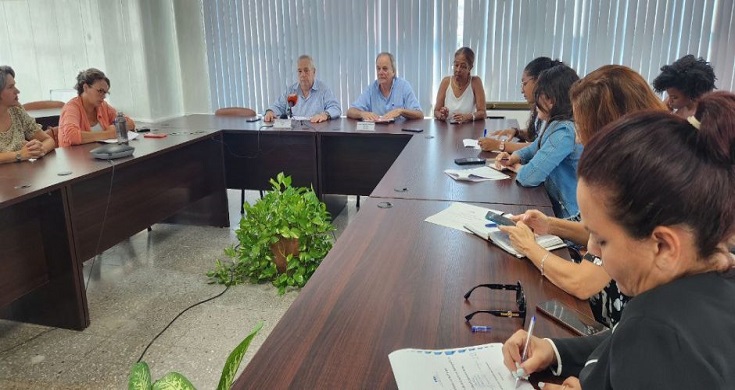Cuba ended the year 2024 with a population of 9 748 007 inhabitants, 307 961 less than in 2023, which showed a decrease of -30.6%, reported at a press conference specialists from the National Office of Statistics and Information (ONEI).
By sex, the ratio was 974 men for every thousand women, with 4,808,909 men and 4,939,098 women.
It should be noted that the effective population is all live births in a year and permanent residents, who accumulate 180 days or more of stay in the national territory.
Fewer births, more deaths, more elderly people
“Population is the most important resource of a country, that is why in Cuba, among other initiatives, we have a Government Commission for Attention to Demographic Dynamics, chaired by the Prime Minister, Manuel Marrero Cruz,” Juan Carlos Alfonso Fraga, deputy chief of ONEI, said at the beginning of his speech.
He also mentioned that the largest of the Antilles shows demographic indicators similar to those of developed countries, such as population decrease and the high rate of demographic aging, although some indicators have deteriorated in recent years, such as infant mortality.
Although some indicators have deteriorated in recent years, such as infant mortality, with 25.7% of the population aged 60 and over, the country tops the list of the most aged countries in Latin America and the Caribbean. In fact, this is the only population group that is growing in the territory.
Villa Clara remained the most aged province. At the municipal level, Plaza de la Revolución, in Havana, registered the highest number of elderly people, with 36.8% of persons in that age group; unlike Yateras, in Guantánamo, which with 17.1% is the least aged municipality.
Last year, Cuba had 710 people of inactive age for every 1,000 people of active age. Although the figure was similar to the 1970s or 1980s, at that time the population from zero to 14 years old had much weight in the inactive group, unlike the current times, when the determinant is the population aged 60 years and older.
According to Alfonso Fraga, 2024 was the fourth consecutive year in which birth rate indicators fell below 100,000 births, with 19,034 fewer than in 2023. According to the executive, this 2025 the figure should continue to decrease.
He also explained that the total fertility rate (the average number of children a woman would have during her lifetime if fertility conditions remained constant) was 1.29, the lowest in Cuban history on record, in a population that has not exceeded replacement indicators since 1978.
Although the adolescent fertility rate decreased with respect to previous years, its number remained high. As more individuals died than those who were born, the natural growth rate registered negative values, a sustained behavior since 2020.
Camagüey, Cienfuegos and Havana were the territories with the greatest population decrease, with values of -39.5, -39.1 and -35.4, respectively; while Santiago de Cuba and Granma had the lowest incidence in this aspect, with values of -25.0 and -24.7.
In the words of Alfonso Fraga, Cuba has registered a negative migration since the 30’s and 40’s of the last century.
The total migration balance rate in 2024 continued with negative indicators, with -25.4 per thousand inhabitants, although the figure was the lowest since 2022.
The figures ranged from -34.2 per thousand inhabitants, in Camagüey, to -20.7 per thousand in Pinar del Río, with the municipality of Antilla in Holguín being the lowest emitter, with -0.1.
Heterogeneous distribution
The distribution of the Cuban population continues to be heterogeneous. Havana alone concentrates 18% of the population, with 1,749,944 people, and if the inhabitants of Santiago de Cuba and Holguin are added, the figure rises to 37.2%. These three provinces occupy only 14.6% of the national territory.
In contrast, Artemisa, Mayabeque, Cienfuegos, Sancti Spiritus, Ciego de Avila, Las Tunas and Guantanamo cover 34.9% of the territory, with a population of 29.2%.
The areas with the lowest population density are the special municipality Isla de la Juventud and Camagüey, with less than 50 inhabitants per square kilometer.
Preparing conditions for the next census
At another point in the press conference, Diego Enrique González Galbán, director of ONEI’s Center for Population and Development Studies, referred to the start of pre-registration for the population census, which began on Monday of this week in 39 municipalities in Havana, Ciego de Avila, Sancti Spíritus and Camagüey.
“During this stage we seek to ensure the planning of the census registration. In each dwelling or housing unit, social workers, as duly identified enumerators, ask two questions: the name of the head of household and the number of people living there,” he said.
This period will have a minimum duration of two months. The expert assured that the data are anonymous, for quantitative purposes. However, in case of any doubt, the population can communicate through the mail registroprevio@onei.gob.cu.
Subsequently, the census will be tested in the municipality of Santa Cruz, where everything designed will be tested.
The census will be computerized and the specialists intend to geo-reference the statistical information.
The objective of this work is to make official data available to users with a disaggregated level of information, which allows taking into account demographic indicators for decision making and a better understanding of society.
(Taken from cubadbate.cu)



